JOUSTRA DIACLONE CAMÉRA ROBOT (REFLECTOR)
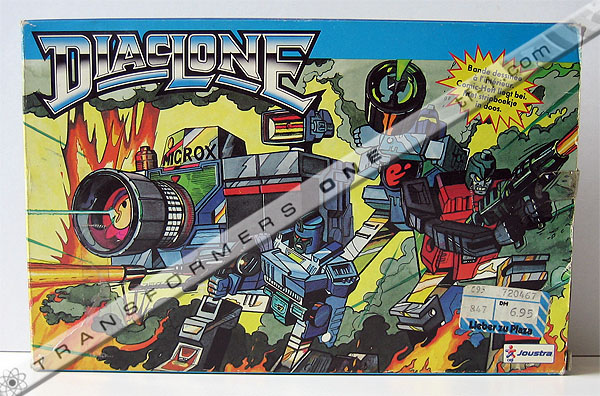
Take a fantastic Japanese toy of high quality, secure a licence to sell it in many major European countries, commission two very talented artists to produce the most beautiful artwork that toy will ever receive, create your own character and surrounding story for said toy including said beautiful artwork, now what do you have? The Takara-licensed Ceji Joustra "Diaclone" Caméra Robot. This jaw-dropping Joustra release of a well-loved mould features some of Paul and Gaetan Brizzi's finest artistry and is by far one of the highlights of the first wave of Ceji Joustra Diaclones.
Having seen a number of these Joustra Caméra Robots throughout the last 10 years, I've had ample opportunity to shell out and land one for my collection as it is not considered among the rarest of this obscure subline of pre-TFs. The trick is to find one in complete condition, unworn, unused and including the unique stickersheet and comic/catalogue. Unlike Japanese and Italian Diaclones which can have some parts and contents interchanged without difference, Joustra releases tend to have more of a hybrid transitional nature. If you commit to an incomplete Joustra specimen with missing paperwork, chances are it will remain incomplete for years to come, if not indefinitely. As I have owned and regrettably sold 2 Transformers Reflectors in my collecting history, buying this Joustra Caméra Robot with all parts and unused complete paperwork at a reasonable price was a complete no-brainer for me.
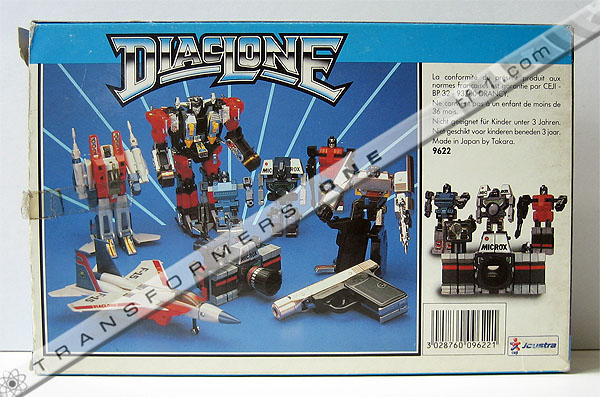
As stunning and intriguing as Joustra packaging is, there's always something that warrants a double-take. The back of Caméra Robot's box shows a very standard Joustra stock photograph featuring Diaclone F15, Microchange MC-05 Microx, MC-07 Browning and Diaclone Multiforce14. Apart from some dodgy transformations and F15's fists on upside down, it's not quite as wild as the Joustra car packaging that shows yellow fists on Trailbreaker, but it still shows Japanese toys unlike what was actually packaged inside most of the Joustra boxes. Caméra Robot's 9622 assortment number is seen on the box back as well and as part of its barcode.


Just like the F15's packaging, the Caméra Robot's box shows a galactic theme on the box top, bottom and sides. The strangest thing on the top/bottom of the Caméra Robot's box is not the fact that one robot head is still facing forwards in camera mode or that the flash cube is on the wrong side...
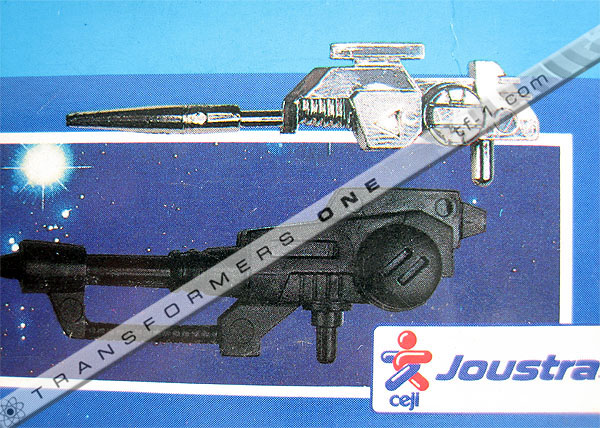
...it's the fact that the third black handgun in the Microx set has been replaced by a Diaclone Porsche (Jazz) handgun! This is one of the more pronounced errors I've seen so far on Joustra packaging. You would probably be disappointed if there wasn't something a little different about a Joustra toy's packaging, but this is quite a glaring error. As with most of the issues I've spotted over the years with Joustra packaging, photography and paperwork, it hints at a very fast turnaround of events between Takara licensing Ceji Joustra to release these toys in Europe, sending them stock and getting that stock out to retailers.
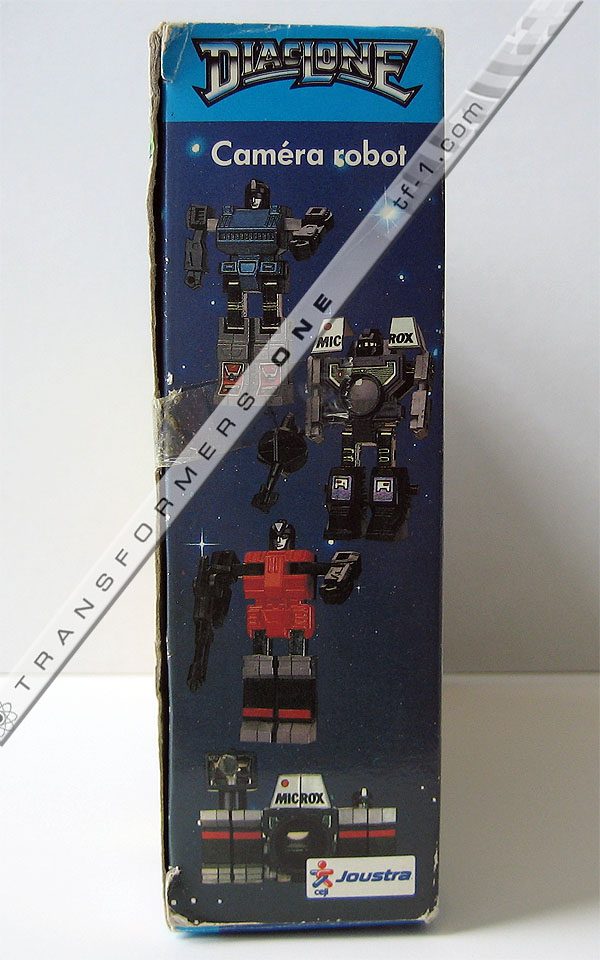
The galactic space theme is much clearer here on the side flap, and it's very strange that they selected this same theme for the Caméra Robot as they did for the F15. I can understand it for the F15, being airborne and having the same kind of background for its boxart, but it seems there was some recycling going on for the Caméra Robot. Maybe since the boxes are of comparable size and they feature in the same comic, they were considered connected, possibly released simultaneously and shared packaging similarities?
Notice how the stock photography on the side flaps again only shows 2 of the 3 black handguns, but this time the "X-in-box" handgun is missing, and so is the one belonging to Porsche/Jazz.
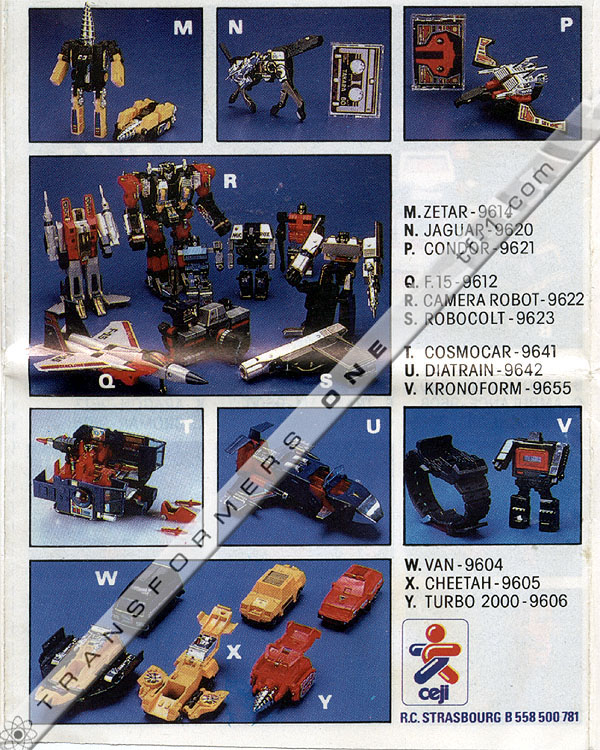
Above is a scan of one of the catalogue sections from the accompanying paperwork showing the same photo of Caméra Robot, F15 and co as on the Caméra Robot's box back. Notice that Multiforce14 has not been assigned an assortment number or designation in this paperwork, one of a number of anomalies in this Joustra literature.
Let's have a closer look at the Caméra Robot's predecessors and wider releases, starting with the original release of the mould; the 1983 Japanese Takara Micro Change Series MC-05 Microx Camera:
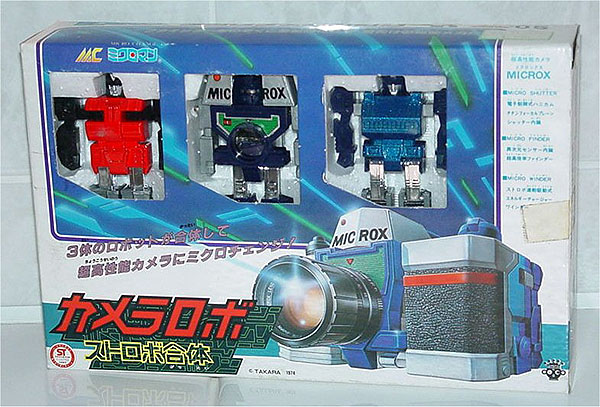
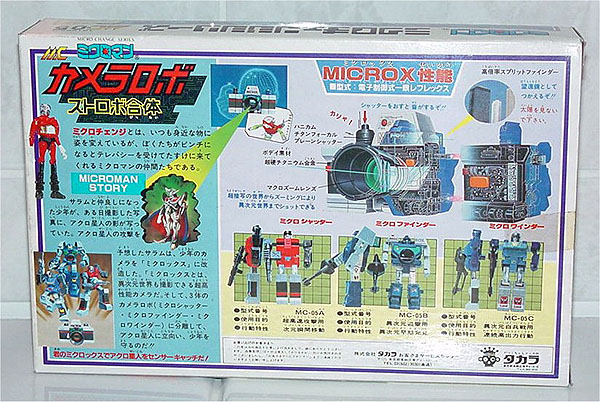
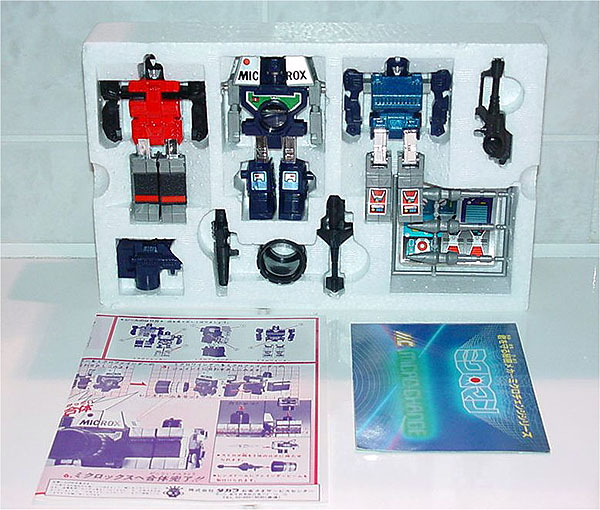
The packaging for the MC-05 is admittedly very attractive, including a slightly less comic-style illustration of the camera mode on the box front and a lovely cut-away image on the box back. You should also take note of the small illustration of all 3 Microx robots in the bottom left corner of the box back, you'll see that again before the end of this article. From left to right, the MC-05 robots were referred to as Micro Shutter, Micro Finder and Micro Winder.
The insert styrofoam is very neatly laid out, a layout which would stay unchanged for every single subsequent release of this mould as a Microchange item, a Joustra Diaclone or indeed the Transformers Decepticon Reconaissance bot "Reflector".
Confusingly, there were multiple moulding differences of this toy. The main things to notice are that the original Microx had no large pegs on the ends of the arms of the middle robot, Micro Finder, and the handgun seen in the top right of the styro has a hollow section between the main barrel and the lower shaft. The gun belonging to the central Micro Finder robot also had a tapered barrel, this had plastic reinforcement added to it for later Transformers releases. Here now is the 1986 mailaway US Transformers "Reflector", the only way to get this Decepticon outside of Japan:
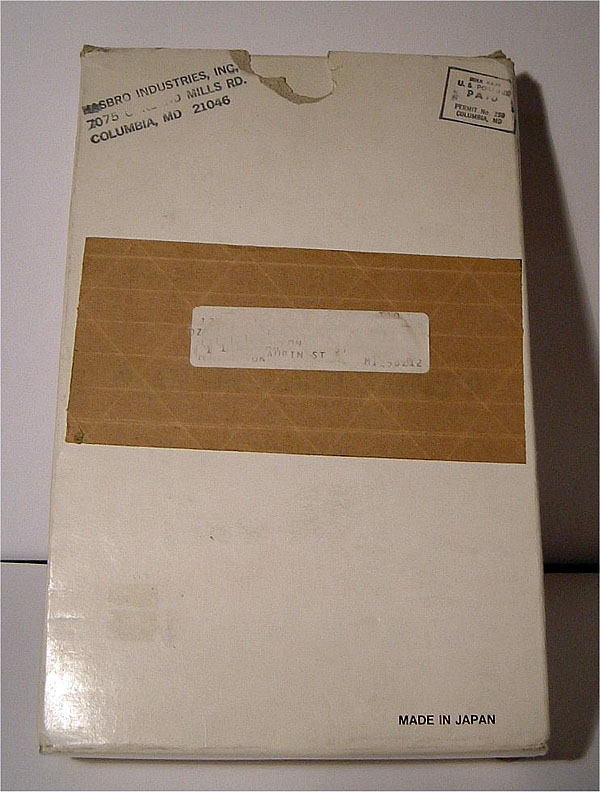
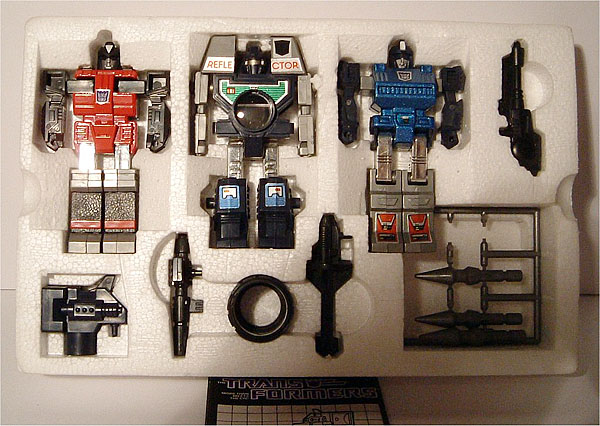
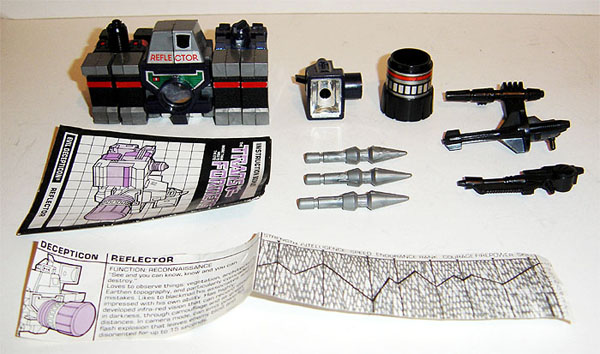
That's all you get, a white mailer box with "12505 Transformer Camera" on it. The same styrofoam layout is used inside the incredibly plain outer white box packaging. Enclosed are a paper techspec and US-style intruction booklet. These robots of course now had new names; "Spectro", "Viewfinder" and "Spyglass". American "Reflector" releases had 2 variants: One was moulded like the MC-05 without the arm pegs on middle robot "Viewfinder", hollow gun for "Spyglass", tapered gun barrel for "Viewfinder" - basically just like the Microx. The second US variant had large plastic pegs on the ends of Viewfinder's arms, solid (not hollow) gun for Spyglass and reinforced 'straight' barrel for Viewfinder's gun ("Lens Laser"). This latter moulding can be seen in the above picture of a loose Reflector.
Sitting in-between the 1983 MC-05 Microx and the 1986 mailaway US Reflector is the Japanese 21 Reflector, a very sought-after release indeed:
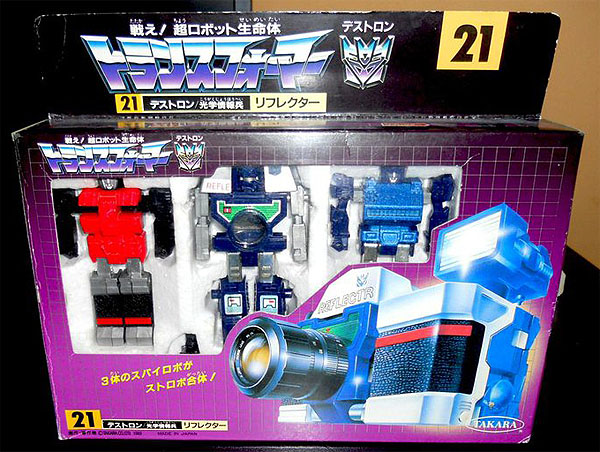
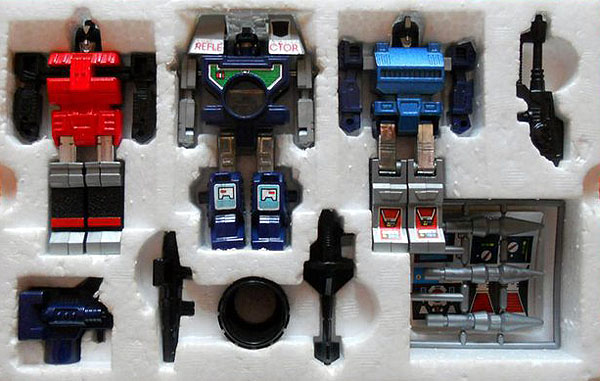
You can see that 21 Reflector's artwork is slightly different to the original Microx camera artwork. The angle of the camera is different for 21 Reflector, and the illustration now features the flash cube. Japan was the only place where you could buy the Transformers Reflector on a store shelf, and it was available in 1985. Notice the mis-spelling "REFLECTR" on the artwork.
Once again, same styro layout, and like the US release there are 2 variants. The first Japanese TF variant is exactly the same as the MC-05 Microx except for missile variations. The second Japanese Reflector is the same as the second US Reflector, again excepting missile variations, and was probably also sold in 1986. More obviously, the Transformers toys no longer say "Microx" across Viewfinder/Micro Finder's shoulders, but "Reflector". You may also have spotted that the 21 Reflector featured above is the first, Microx-like variant.
As implied above, there are multiple missile variations including ones with no tabs around the missile shaft (USTF v1), some with a single tab (USTF v2) and some with multiple tabs (Microx, JTF). The general rule is that US TF only came with single or no-tab missiles, only Microx and Japanese 21 Reflector came with multitab missiles.
The outer packaging differences and inner packaging similarities between the MC, JTF and USTF releases are clear for all to see in the next picture:
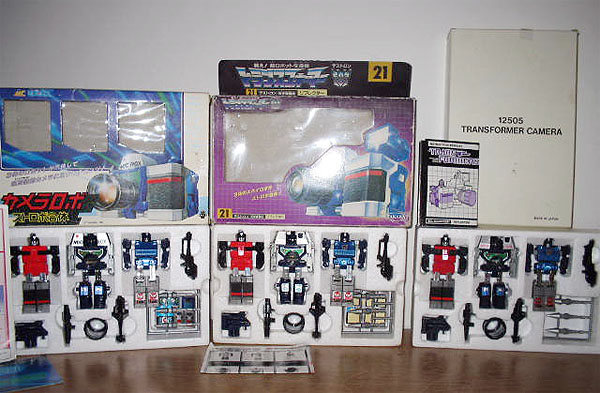
With all that headache regarding the variations in arm pegs, handguns and missiles, where does the 1984 Joustra Caméra Robot sit in all of this? Well for a start, it's the first official release of this mould after the original Japanese MC-05 Microx, pre-dating the 1985 Japanese Reflector and 1986 US Reflector, and it was also the only way to get this mould in Europe. These facts make the Joustra Caméra Robot much more significant than first thought, and that's to say nothing of the magnificent packaging which we will now study more closely:
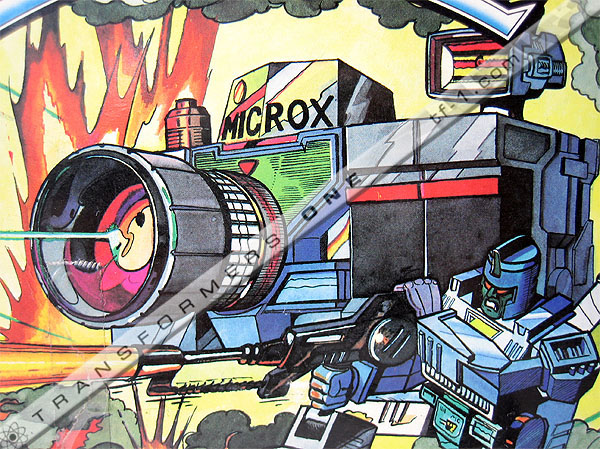
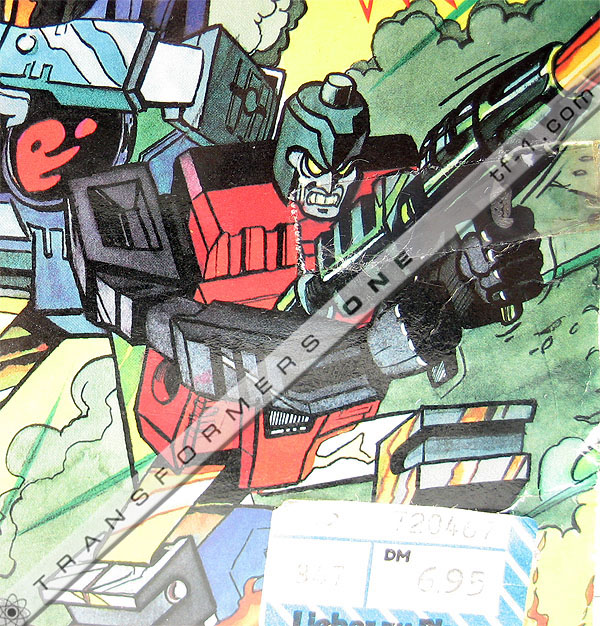
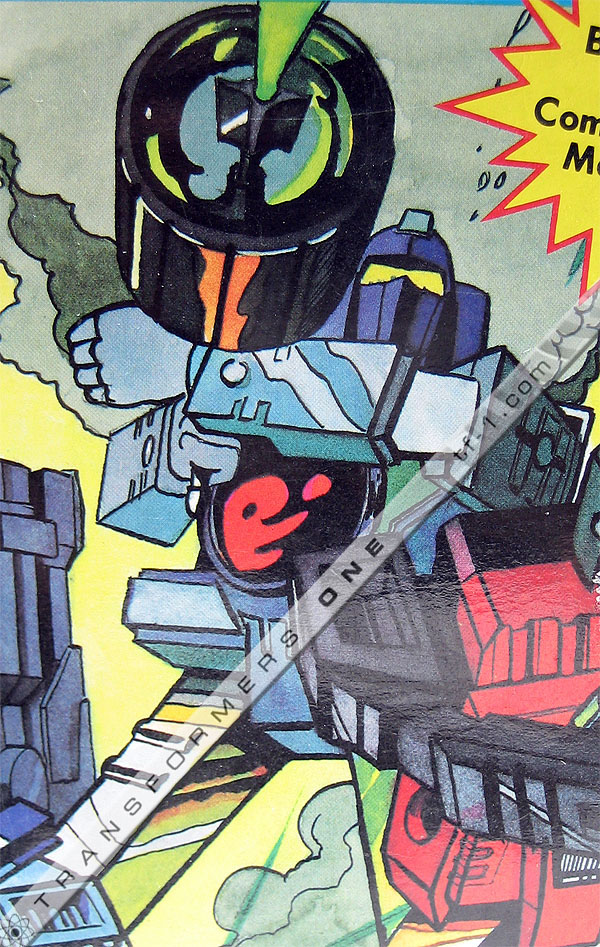
The amount of visual stimulus on the Joustra Camera Robot box front is simply insane (refer to first picture in article for full effect). There are lasers, guns, flames, smoke, explosions and teeth! Not only do we get even more camera artwork (first time it has been depicted as a weapon instead of just a camera), but individual robot art as well, and not just in a corner of the box back. While the poses held by the robots may not be reproduceable by the toys themselves, this artwork is pretty toy accurate. The Brizzis have taken the sterile but pretty Microchange artwork, added the robot modes and a slice of Michael Bay. The artwork features all the correct weaponry, and you may also have picked out the "Microx" and "MC" carry-overs here and there. When viewed as a whole, it is just unrivalled, standing head and shoulders above any other artwork produced for this mould.
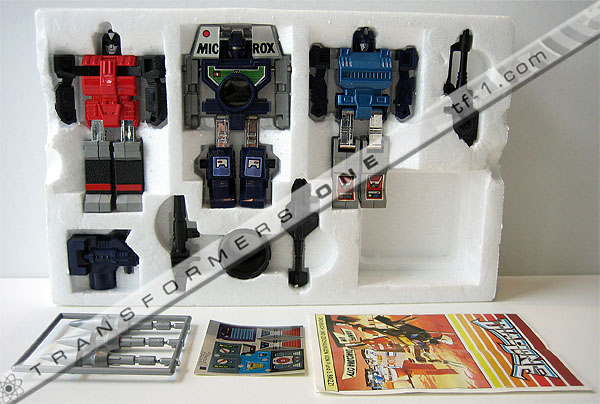
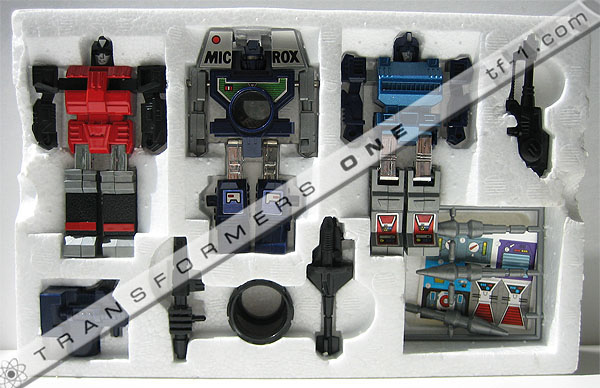
The standard of attractive presentation continues inside the Joustra packaging. Being only the second release of this mould ahead of the Transformers Reflector, it is no surprise to see that the Joustra Caméra Robot features precisely the same styrofoam insert layout as the MC-05 Microx. You may also notice that the "Microx" on the middle robot has been kept, and from the accessory pictures above and below that the moulding is the same as the MC-05 Microx; multitab missiles, hollow gun for "Micro Winder/Spyglass", tapered (non-reinforced) gun for "Micro Finder/Viewfinder" and no pegs on the end of the middle robot's arms.
If you've never seen a Microx/Reflector/Caméra Robot in package, you may be surprised just how small it is. The whole package has roughly the same dimensions as a US G1 jet package minus the box flap. The stickersheet that comes with this set is very small indeed, and you can see the "War On Diaclona" comic/catalogue is present as well.
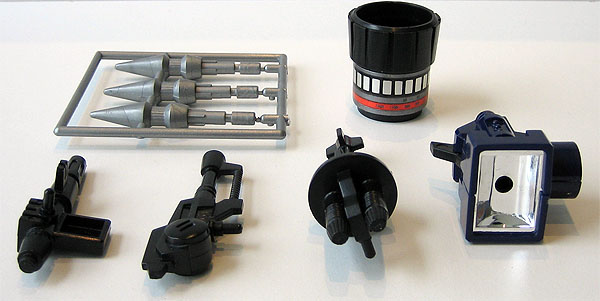
Unlike many of the Joustra Diaclone toys I have reviewed recently, there's no chrome on the accessories here, and to be fair they probably wouldn't have suited the look of the Microx figures as much as they do the Autobot cars. All 3 handguns, missile sprue, lens and flash cube are present. Every accessory seen here can be used in robot mode by the figures, including the flash cube and lens. The hole in the centre of the flash cube is for the missiles, and it clearly has a launching tab on the top of the cube. A fake Microx flash cube/launcher will tend to have a more oval-shaped hole in the middle than this perfectly circular specimen.
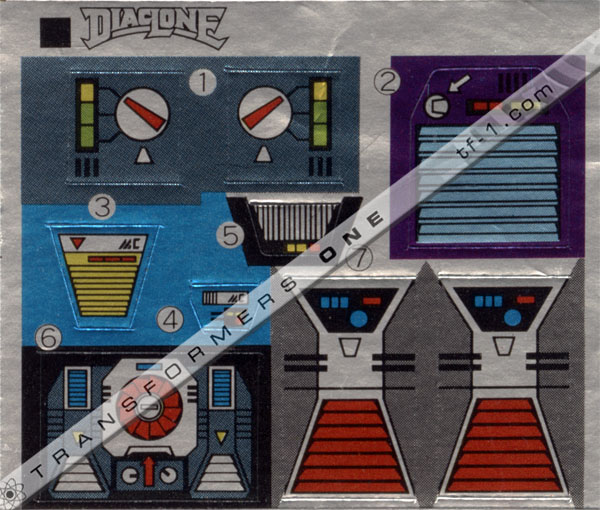
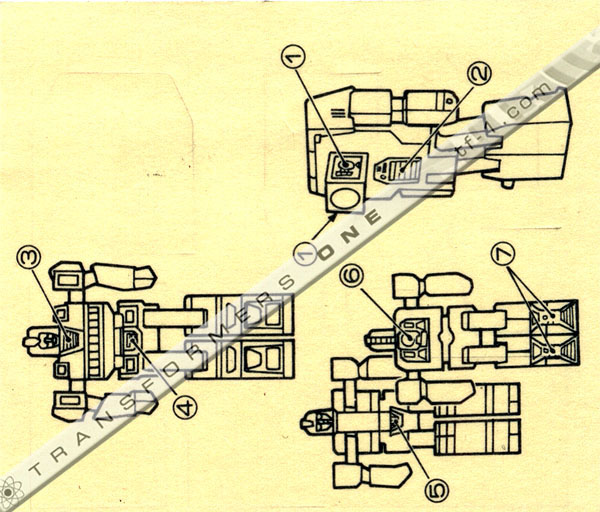
In keeping with all other Joustra Diaclone releases, the stickersheet is precisely the same as the Japanese pre-TF counterpart with the stylised "DIACLONE" writing in the top left corner replacing the original Micro Change MC-05 logo. By looking carefully at stickers #3 and #4, you will be able to see the Micro Change "MC" logo still on the stickers, these would have been removed for the later Transformers Reflector stickersheet.
Also seen above is the reverse of the stickersheet where the sticker placement maps for each robot are printed. This is yet another unique feature of Joustra releases, so it's very simple to spot when you have a Joustra stickersheet.
The comic that is included with the Caméra Robot is the exact same one released with the Joustra F15, "Chapter 6: FIRE IN SPACE" (may explain the galactic packaging theme for both toys), and I have scanned and translated that chapter already HERE. However, I have included in this article a few panels from comic chapter 6 and also chapter 7, which you can find in its entirety HERE.
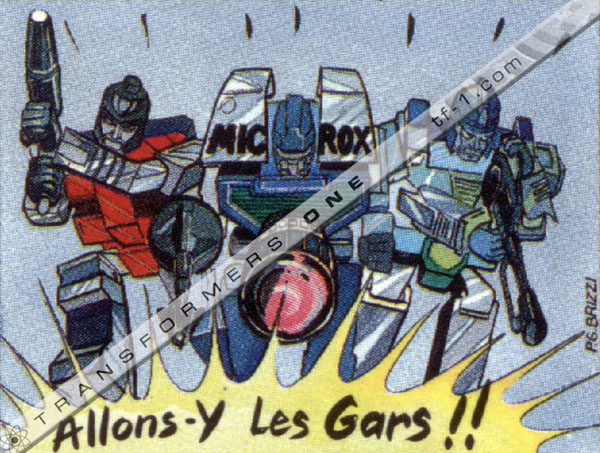
This action shot shows that far from being just a spy camera, in the Joustra universe the three robots making up Caméra Robot are also warriors and not afraid of getting their hands dirty. The above and below scans show Caméra Robot helping to fight off Multiforce14's forces while F15 gets to safety and recovers from injury.
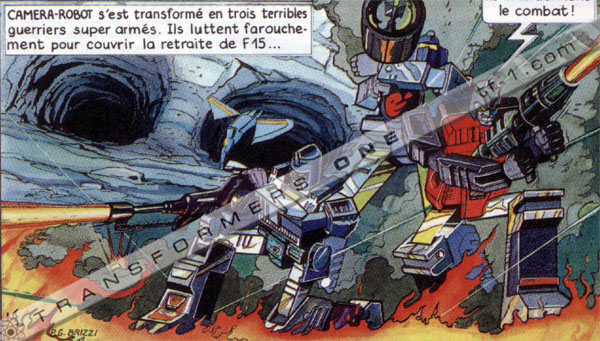
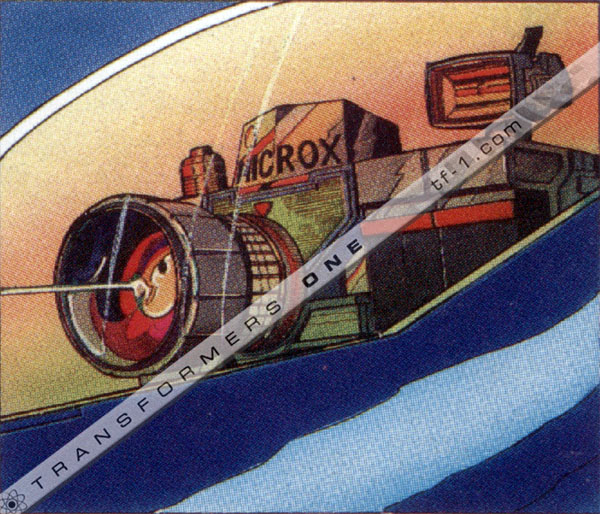
The above two scans from comic chapter 6 are clearly where the Joustra Caméra Robot boxart have been lifted from, but with slightly different backgrounds. The writers refer to the 3 Caméra bots as fearsome warriors which gives them such a huge variety of personality and character in this Joustra Diaclone story compared to their much more limited role in The Transformers. The angry faces on the two side robots really do give the impression that Caméra Robot belongs to the evil faction, however the story clearly portrays them as a force for good. Those facial expressions are just typical of the Brizzi style and are even carried over to wave 2 Joustra boxart, despite the Brizzis not being involved at that late stage.
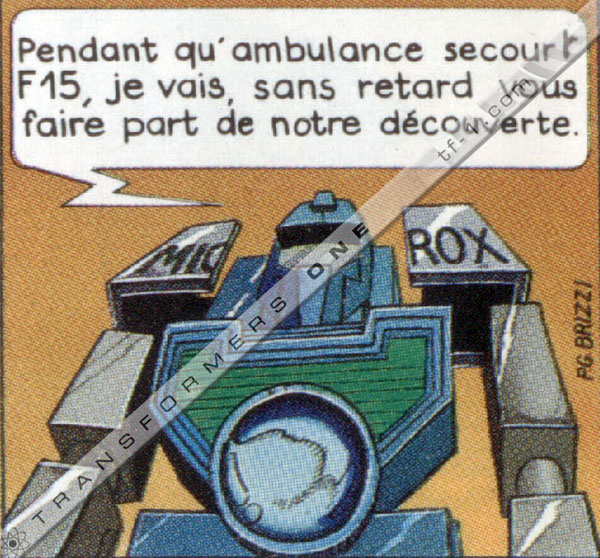
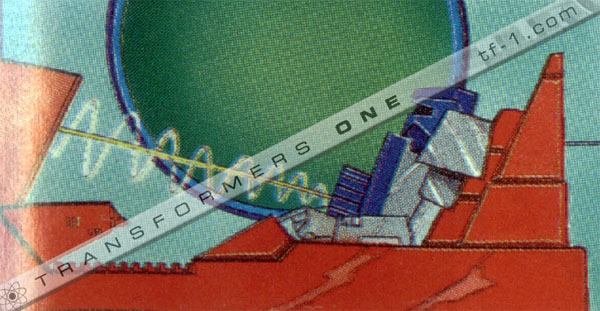
These 2 scans above are from comic chapter 7 where Joustra Ambulance and Cosmocar have come to the aid of the injured F15. Caméra Robot is seen recording the precise coordinates of the secret and powerful enemy base onto a special cassette for immediate distribution. So not only does the Caméra Robot in this story fulfil a sort of Soundwave-type communications officer role, but also that of a spy and a formidable warrior. He is briefly seen in comic chapter 8 as well, so in terms of this particular universe and literature, this toy is a very significant and prominent character, a complete all-rounder.
Having now established where the Joustra Caméra Robot fits in to the Microx moulding and release timeline, and discovered the role this toy plays in the War On Diaclona tale, it's time to examine the actual figures themselves in order to see if the high standard is maintained throughout.
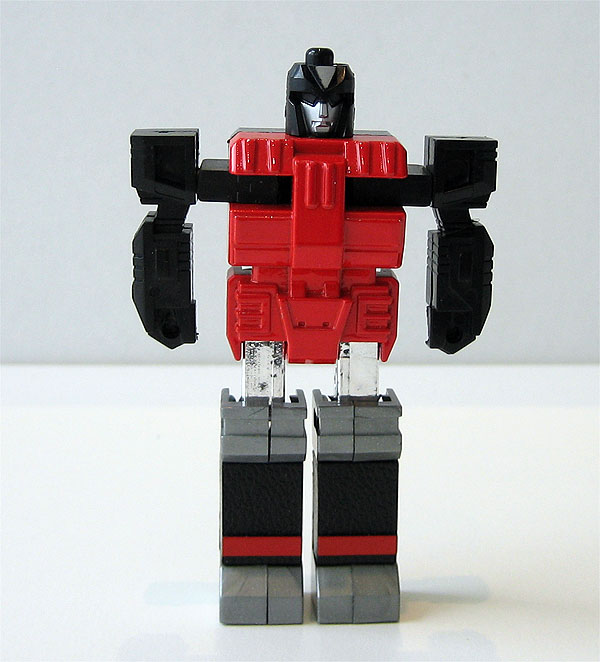
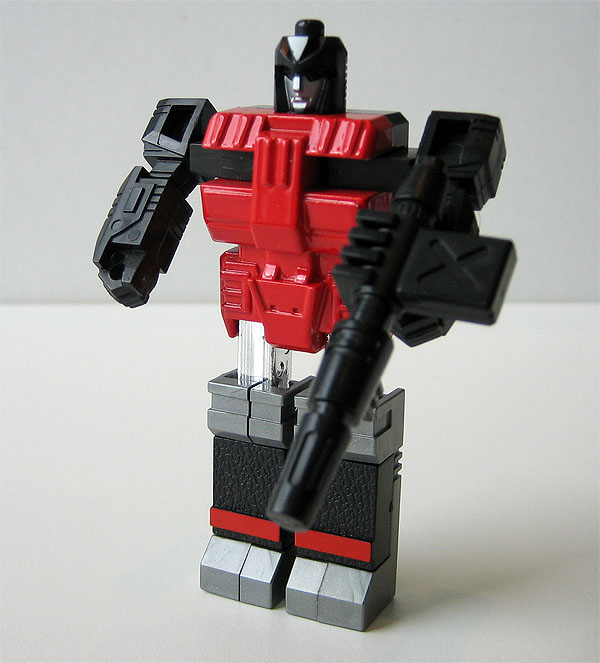
Starting with he who was "Micro Shutter" and later became "Spectro", we can see that the individual bots in the set are very simple indeed with highly limited poseability. While it may appear that there are few distinguishing features for this particular bot, I think his head sculpt and facial features are brilliant, my favourite of the three by far. The robot as a whole has a striking red torso, the implied black leather shins and pretty chrome thighs. The little button on his head is meant to activate the shutter and makes a very satisfying click when pressed. The wide shoulders provide a healthy amount of bulk for what is quite a diminutive robot. You can probably tell just from these photos that this figure will transform by folding the arms inwards and the legs backwards.
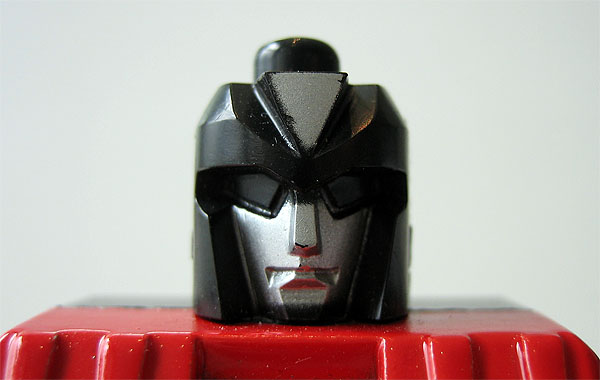
That is a very strong head sculpt in my opinion, even with the slight imperfections in paint application. The neck on this figure is not articulated.
Moving on to he who was "Micro Finder" and would become "Viewfinder"...
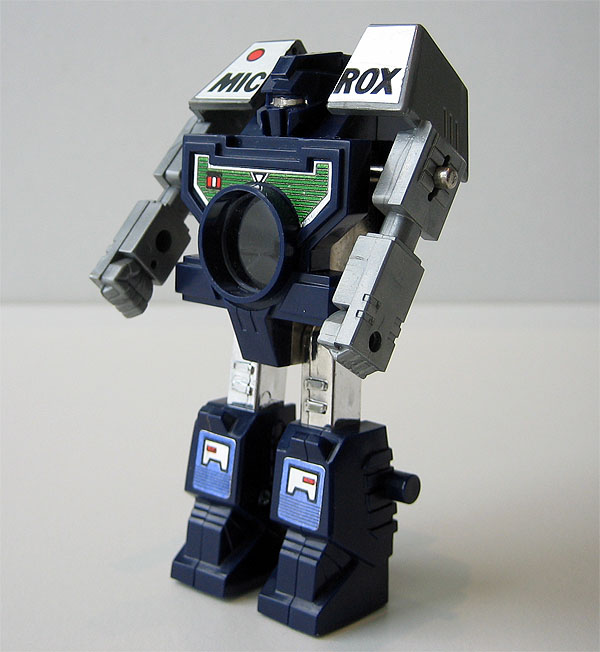
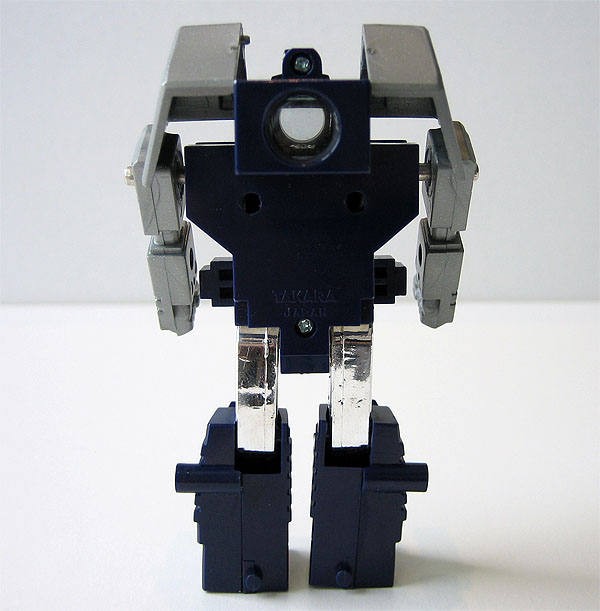
A very different looking robot but the same basic principle of articlulated plastic arms and chromed thighs. Despite the articulation in the legs it's very hard to actually pose the figure differently so that he can appear in-motion. This middle robot is without question the most recogniseable and distinct of the three Caméra Robot members, boasting the huge aperture on his chest, the "MICROX" lettering across his bulky shoulders, and the very cool working, magnifying periscopic viewfinder on the back of his head. The overall colour scheme is not quite as striking as the first robot but the grey/blue motif is very successful with the addition of chrome. The Seven Microx model kit that is slightly smaller has this same colour scheme throughout all 3 robots and that works very nicely (see HERE)
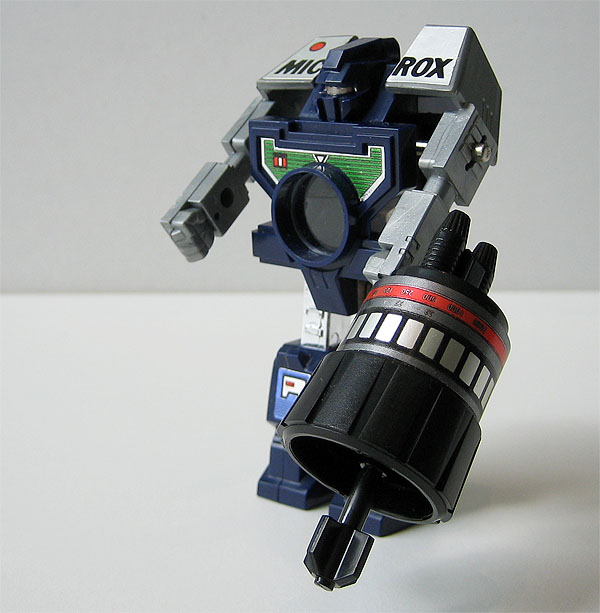
Not only can the central "Lens Laser" gun be attached to the outside of his fists, but the gun can be combined with the telephoto lens accessory for an even larger weapon as shown on the boxart. The detail on the lens factory stickers is a really nice touch, much like the working viewfinder and clicking shutter. If you look where this robot's shoulders end, you can see the silver rod which the arms slide in and out on. It appears as though with this mould the arms can come right off, which is why later moulds have the larger pegs on the ends of the arms referred to earlier to help keep them attached. The green chest sticker on this middle robot is another signature feature which was even carried over to the cartoon version of Transformers Reflector.
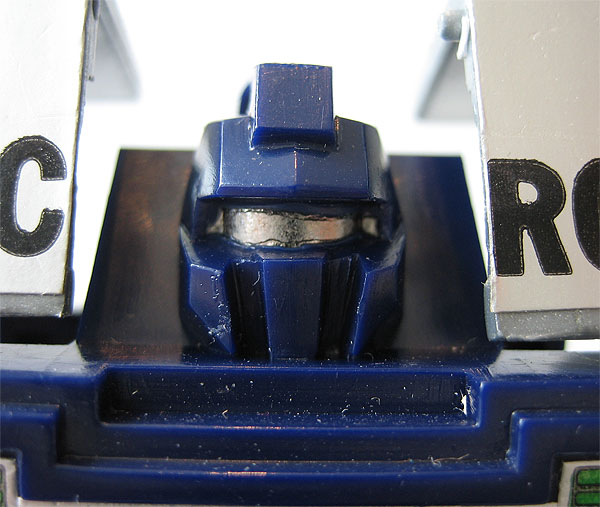
The middle robot has a much more robotic and non-human face sculpt which is entirely suitable. In fact the variety in the head sculpting of the three individual robots is something I appreciate, especially as the G1 cartoon Reflector bots were identical apart from Viewfinder's aperture. I'm also pleased to see the eye band is not just the same colour as the head but has been painted silver.
On to the last robot, he of earlier "Micro Winder" and later "Spyglass" fame...
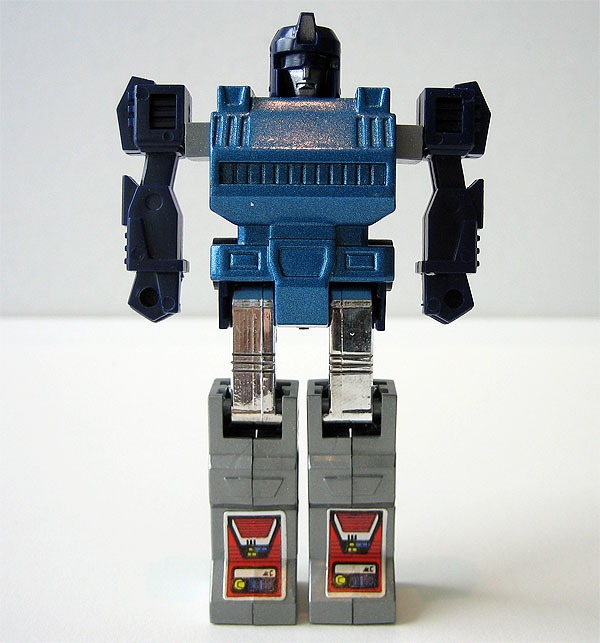
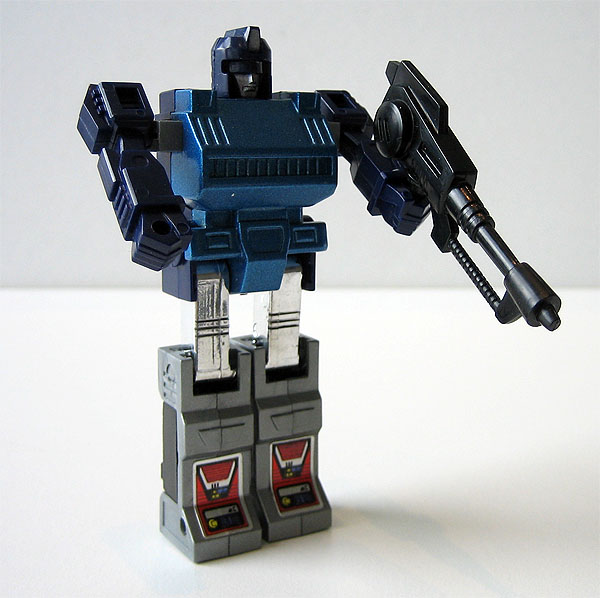
The third robot in the set, and just as interesting as the previous two. Out of the three members, this figure undoubtedly has the most functional poseability. The arms are not only exquisitely moulded and styled, but are of course poseable, and due to the nature of the transformation and outwards folding of the arms they can add greatly to any pose this bot can hold. The legs can also be bent at the knee and he can hold a walking pose which you can see below:
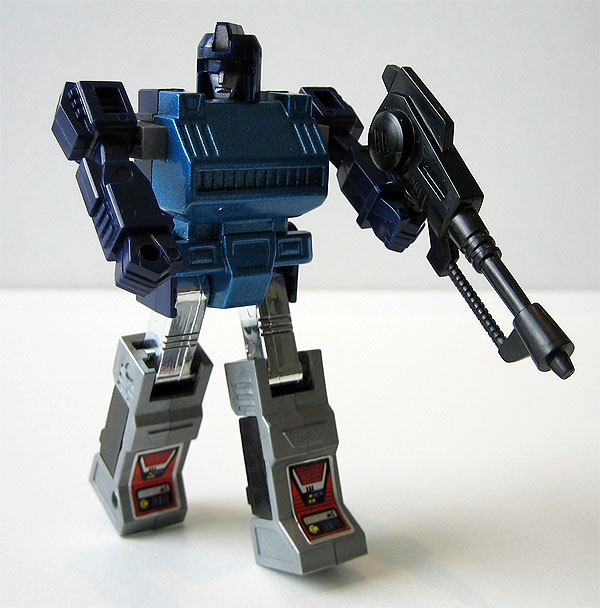
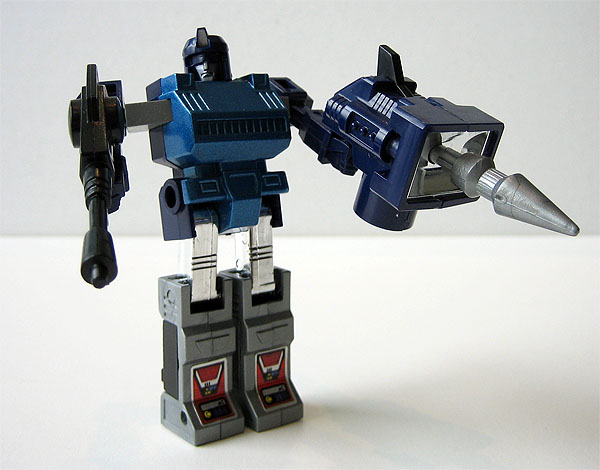
As mentioned previously, the flash cube can be combined with the missles to create a launcher weapon, which does indeed launch the projectile well. Considering the size of the robot, he is incredibly well-armed with relatively large weapons. He also has an articulated neck which adds a further dimension to his poseability. This robot's implied black leather section is now on the back of his legs, so his shins are grey plastic sporting factory stickers. The sparkly blue chest works nicely with the chrome thighs.
The head sculpt below shows the well-used sunglass-like eyeband but a humanoid face with a large head grill, again demonstrating the variety between three little robots that could easily have been indistinguishable from each other.
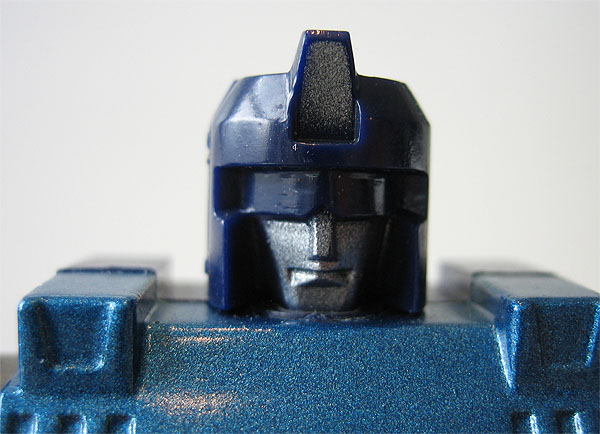
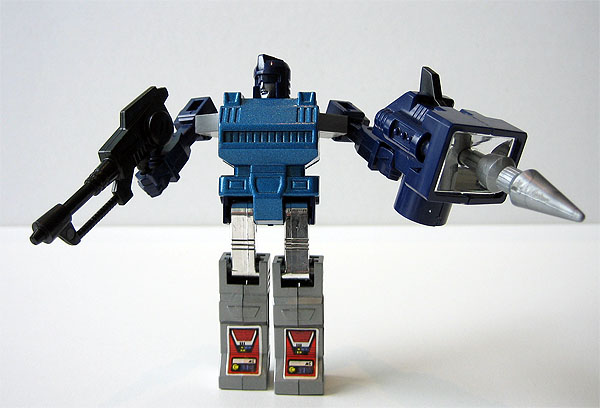
One more robot mode picture above for the third robot brandishing his weapons, just because I like it that much.
Here are all three Caméra Robot members together, making up this exceptional team of well-armed, multi-gimmicked warrior communicator spies!
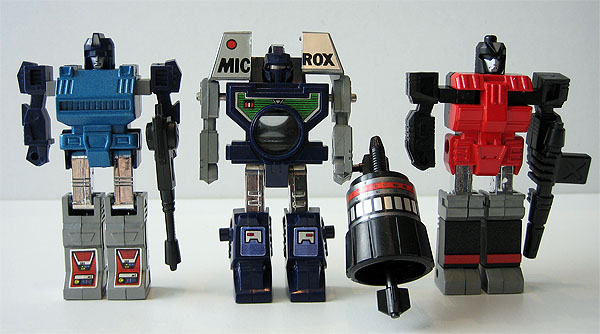
Whatever angle they are viewed from, they are as impressive as they are small and are so far from looking plain that you can afford to leave the sticksersheet decals unapplied. While they are all of similar height, the central robot's head sits a little lower on his body than the others.
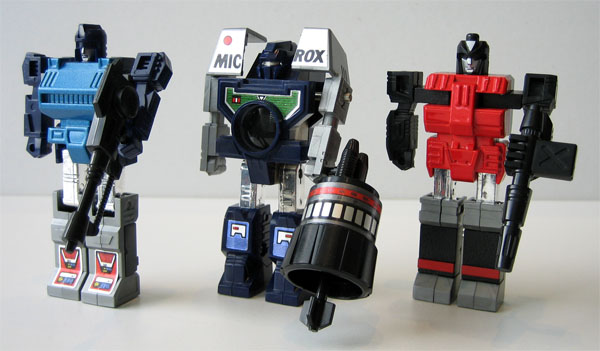
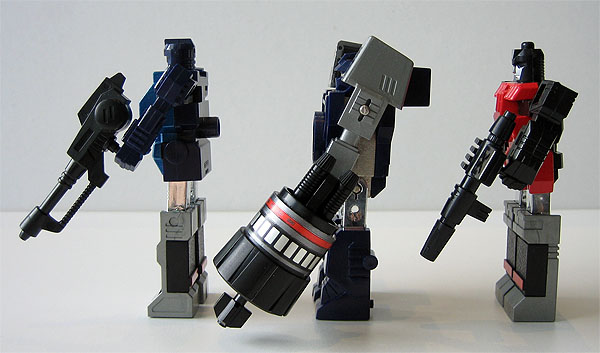
So far, the Joustra Caméra Robot has exhibited exactly the same moulding features as the original Japanese MC-05 Microx (hollow gun, multitab missiles, no arm pegs, tapered middle gun), and the copyrights on each robot exactly match the Japanese toy as well, simply stamped "TAKARA JAPAN":

So all things considered (moulding, stickers, accessories, functionality), it is right up there with the original release, but with all the typical Joustra extras. A very strong release so far which maintains that constantly referred to high standard well into the combined camera mode:
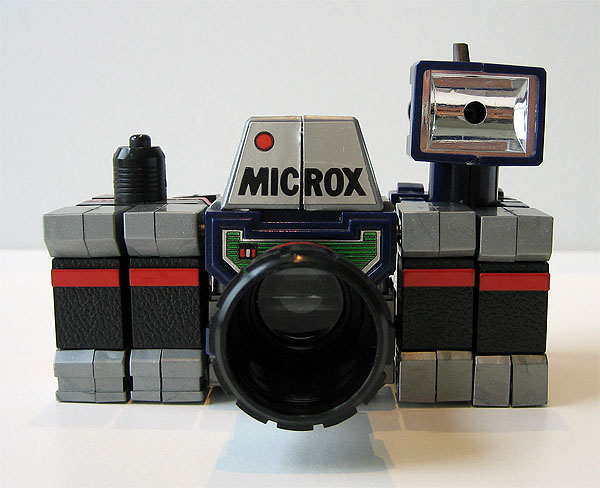
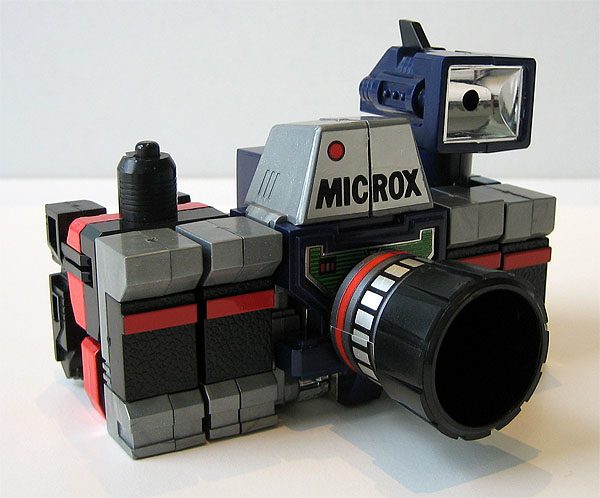
Just beautiful. Great proportions, a lovely feel to it when all clicked together, nicely detailed accessories and a perfect size too. These pictures demonstrate that the Caméra Robot is a looker in every mode. The only possible gripe would be that the robot arms for the side bots are visible in camera mode and are prone to being rotated when handling the camera, but the front view just makes up for that in spades. I can see that a used and worn specimen would have a little difficulty maintaining its shape and alignment in this mode due to loose leg joints which make up the flanking sections of the front of the camera. Also stickerwear could have a marked effect on displayability, so I'm very thankful to have found a pristine example for this review.
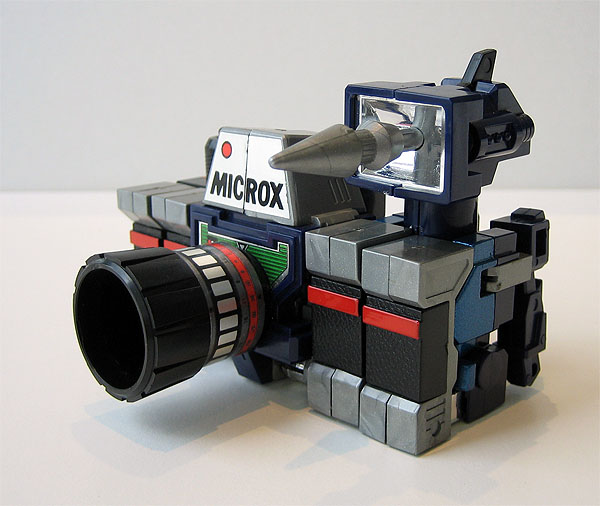
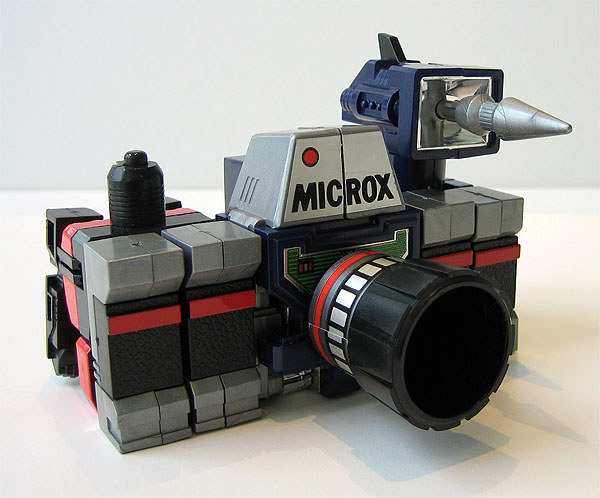
The flash cube is again used as a missile launcher in this mode, and in addition to that, the lens laser can be attached (but not quite as flush as you would like) to fashion an even more aggressive look for the Caméra Robot in this configuration:
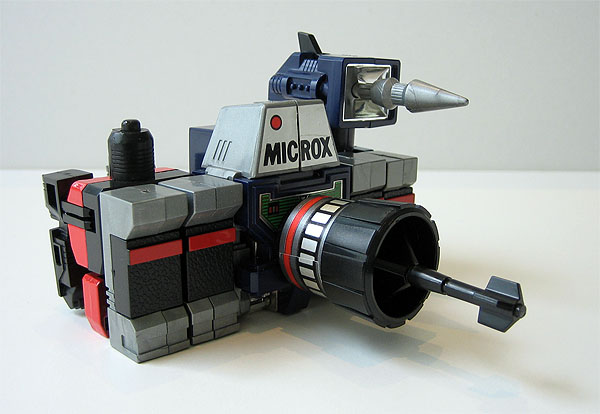
I think were I to display this item out of packaging it would either be in camera mode without any weapons attached, or as three robots fully armed to the teeth. And the Joustra versions do definitely have teeth! The lens laser and missile are nice, but the plain camera mode look is far superior without them attached.
Here are some close-ups of the standout camera mode features:
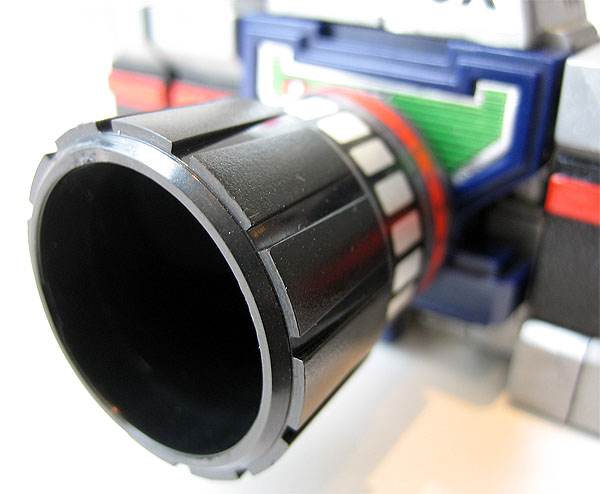
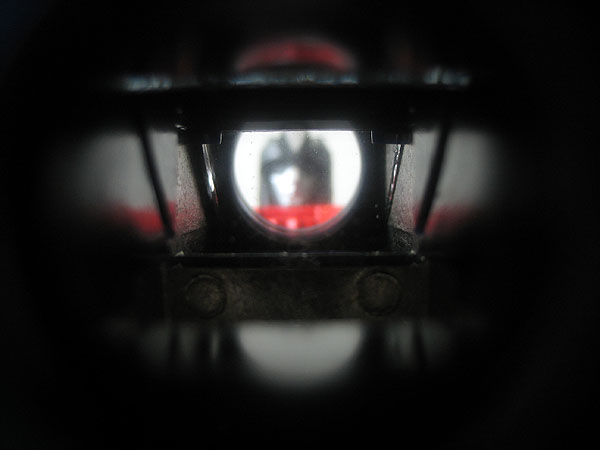
The photo above shows to some degree the working viewfinder on the camera. In real life the image through the viewfinder is much sharper and in focus than I have been able to demonstrate with my photography, and it's really a stellar inclusion for this figure.
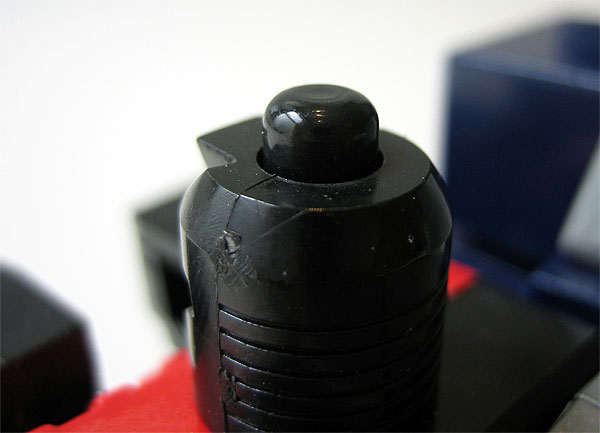
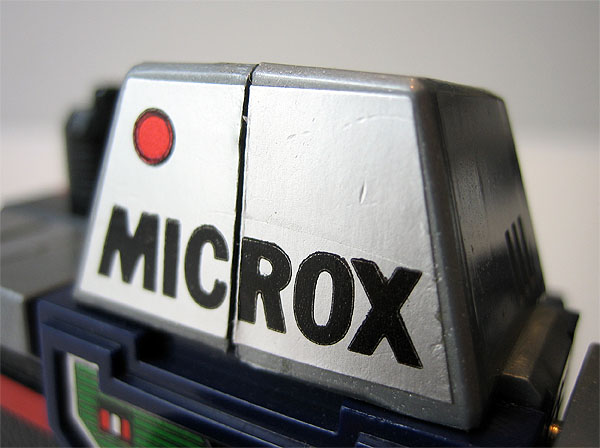
Very often it's the small touches and attention to detail that make a toy or action figure stand out amongst its peers and remain entrenched in one's happy memories, and this Caméra Robot is covered in such features. So many little things that you can't help saying "Now that's cool" to. Somehow, that large "MICROX" lettering across the top of the camera is more suitable than "REFLECTOR" and feels a bit more true to the nature of disguise.
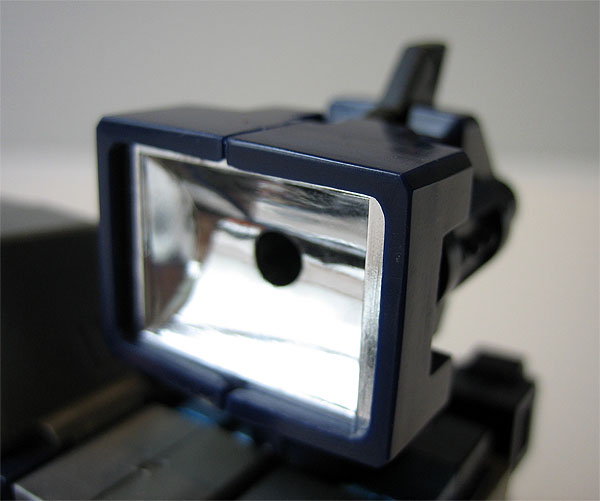
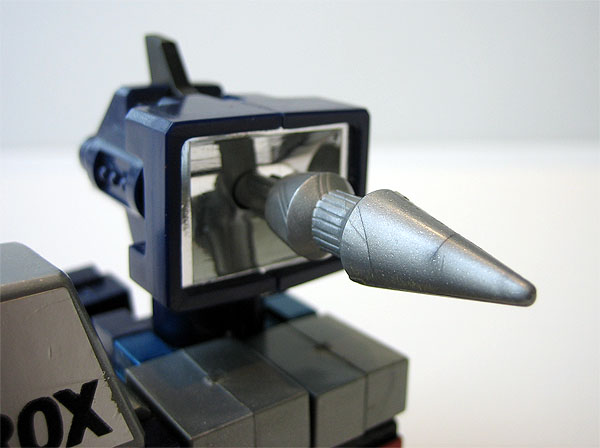
Below you will find pictures of the later-version US Transformers Reflector in both modes, still looking divine and keeping all nifty features of the original, bar the firing missiles:
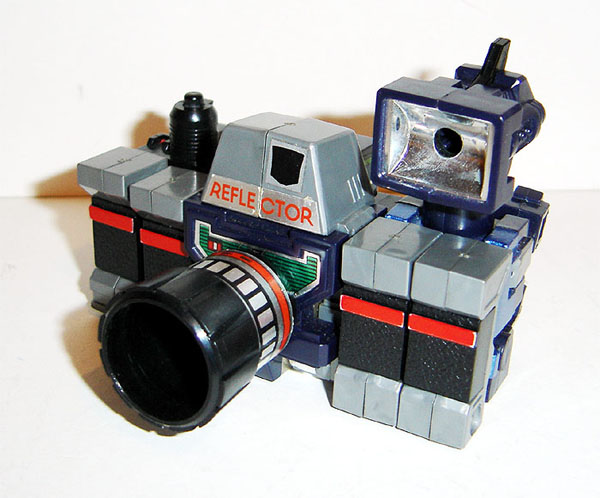
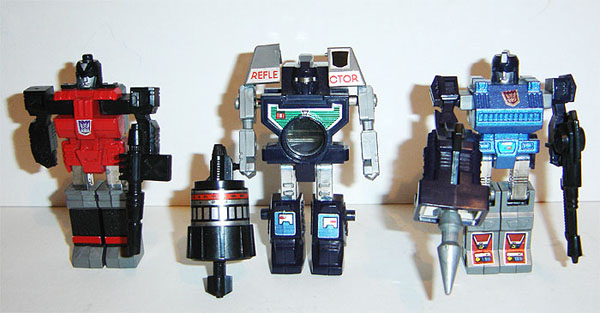
The "MICROX" silver stickers across Viewfinder's shoulders have been trimmed down to make room for the rubsign, and to be fair I think as far as rubsign placement goes it's pretty good, despite its high visibility location. Spectro and Spyglass now have Decepticon stickers on them as well and you can see Viewfinder's large pegs on the ends of his arms. Notice the solid handgun and single-tabbed missile on Spyglass, fitting in nicely with USTF v2 moulding. It is confusing, but you can definitely identify the right parts for your Reflector/Microx. If you need your robots to have factions and belong to the Transformers universe, then Reflector will certainly not let you down. I loved my TF versions deeply.
Of course, the Joustra Caméra Robot has just as much faction allegiance, personality and character as the TF depiction, if not more. Since this is a toy based on a camera, I thought it fitting to try and take a couple of arty black and white snaps of the Caméra Robot members which their interesting head sculpts lend themselves to nicely:
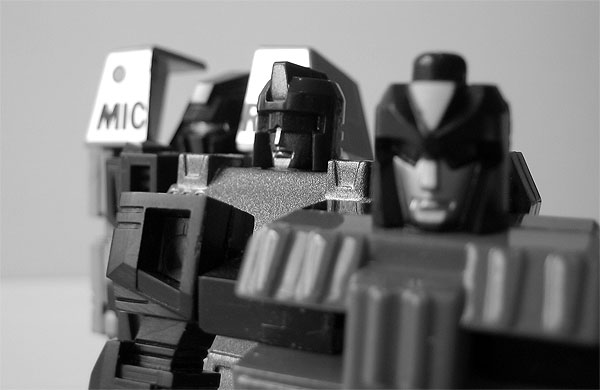
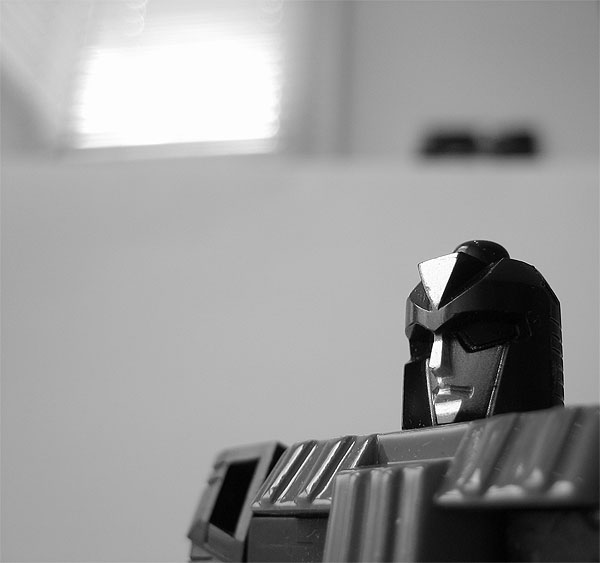
It just goes to show that this figure doesn't rely on colour for its appeal or charisma, and I guess I shouldn't be surprised at how photogenic it has turned out to be.
Now, remember the small robot artwork in the bottom left corner of MC-05 Microx's box back? Well here is a full-size version adapted for use with the Transformers Reflector, featured on Reflector Kabaya kits, Television Magazine and the Laserdisc set:
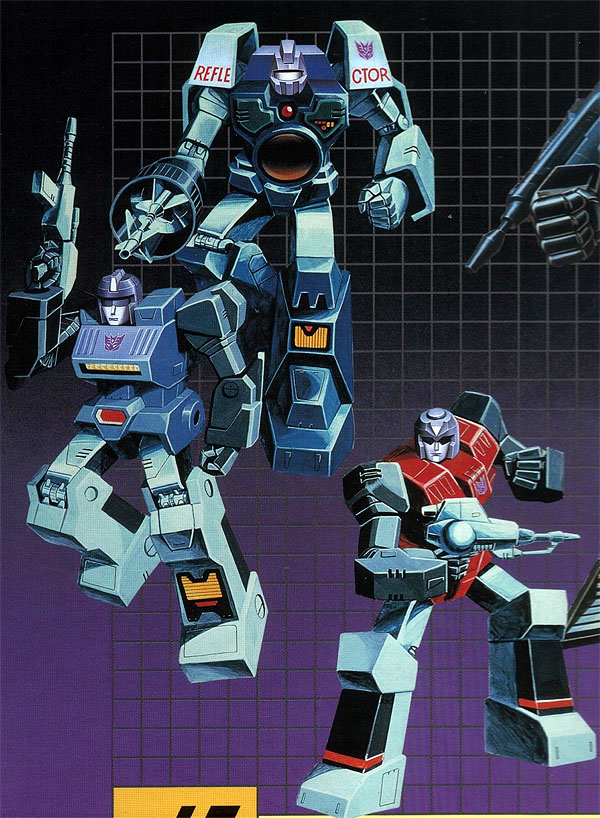
A scan of US Reflector mail-order paperwork:
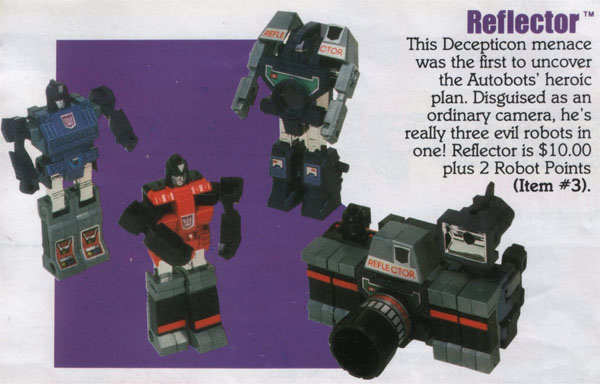
Some screen captures from Transformers: More Than Meets The Eye featuring the G1 cartoon Reflector:
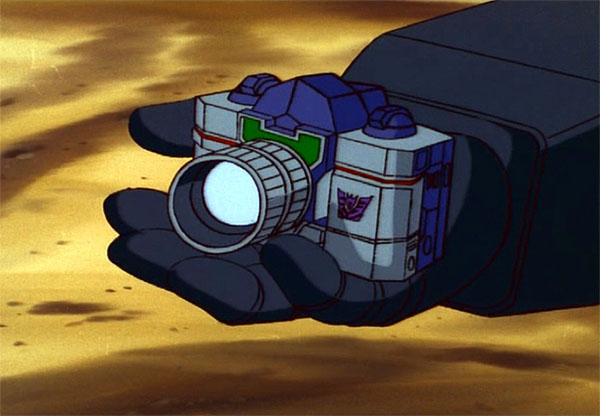
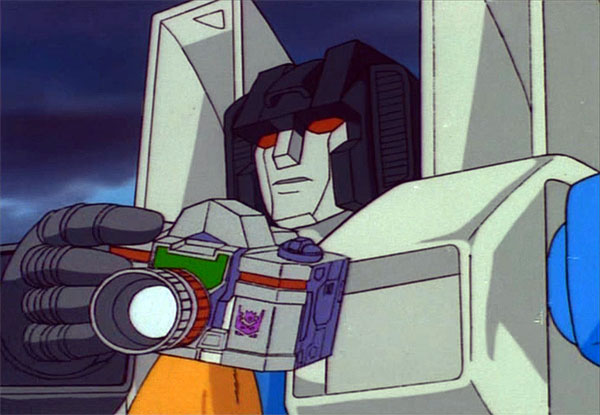
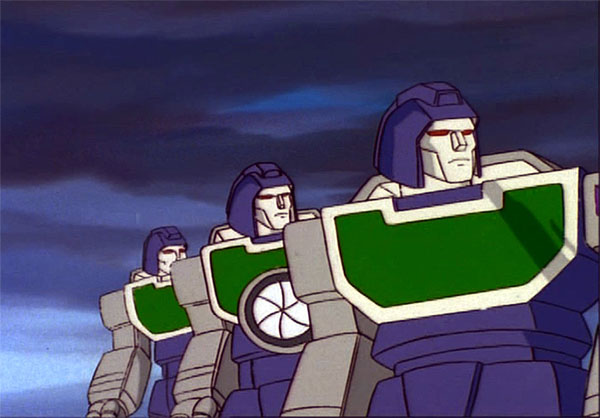
Images of the hardcopy resin prototype for the Microx mould:
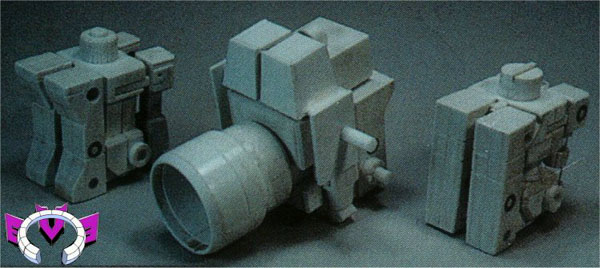
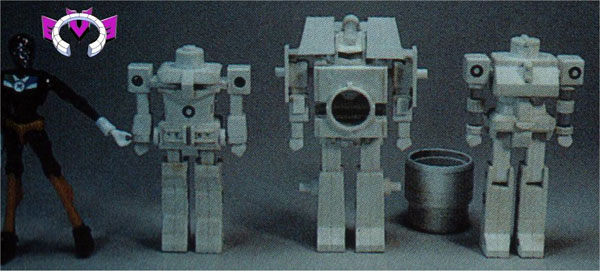
A lovely scan of some paperwork featuring the MC-05 Microx toys:
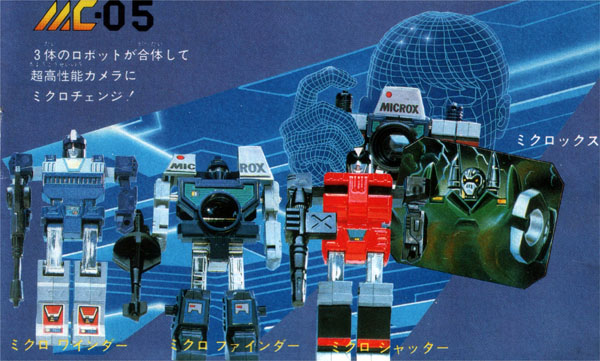
Early Micro Change campaign prize trading cards featuring the MC-05 Microx:
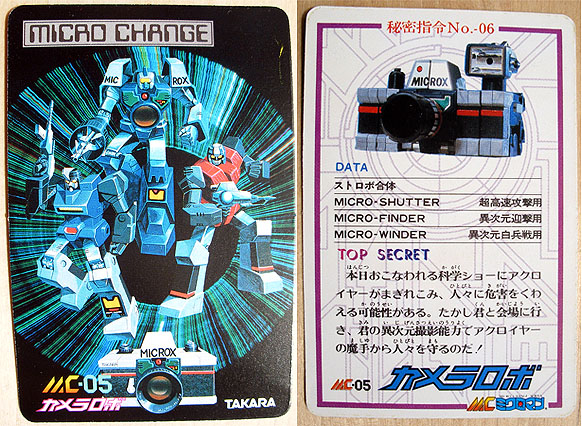
And finally, just to demonstrate its relative size and that even by Brizzi standards this one's really a stunner, here is the Ceji Joustra Caméra Robot alongside a group of other wave 1 Joustra releases from the same era:
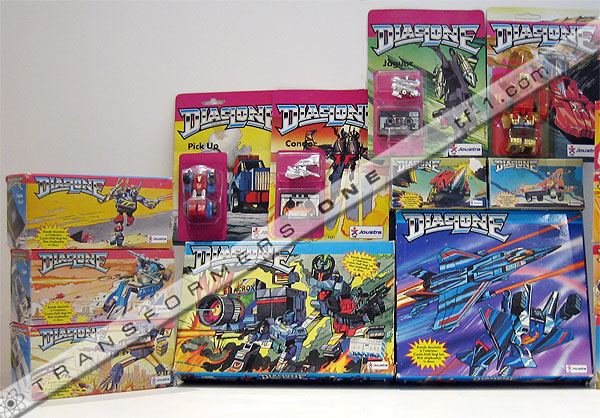
I can completely understand the desire for fans of these toys to restrict themselves to Transformers releases, and of course the Takara 21 Reflector is probably the most expensive and sought-after of all when it comes to this mould. For those who want to collect beyond just Autobots and Decepticons, the MC-05 Microx is the first release of the toy and there is a distinctly Japanese feel to its maiden outing, which appeals to a great deal of collectors. For me, as with most preTF/G1 moulds, the Joustra Caméra Robot is the only choice. Not only do I collect toys but also toy artwork, so the appeal of the Joustra packaging - even without a window box displaying the robots - wins out every time, and the mould is precisely the same as the MC-05 Microx. The character given to Caméra Robot is the best and most rounded the toy has ever been afforded, it has working missile launchers and will cost you less than a Takara 21 Reflector, and you need not worry about being fooled by one of many MC-05 KOs.
So they took a fantastic Japanese toy of high quality, secured a licence to sell it in many major European countries, commissioned two very talented artists to produce the most beautiful artwork that toy would ever receive, created their own character and surrounding story for said toy including said beautiful artwork, and what did they have? One of the very best pre-Transformers toys ever made and released, that's what.
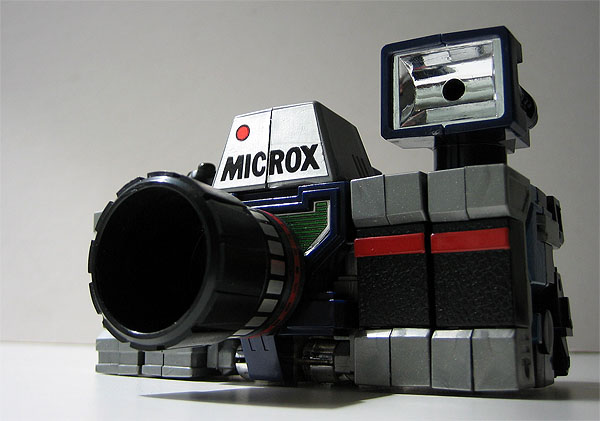
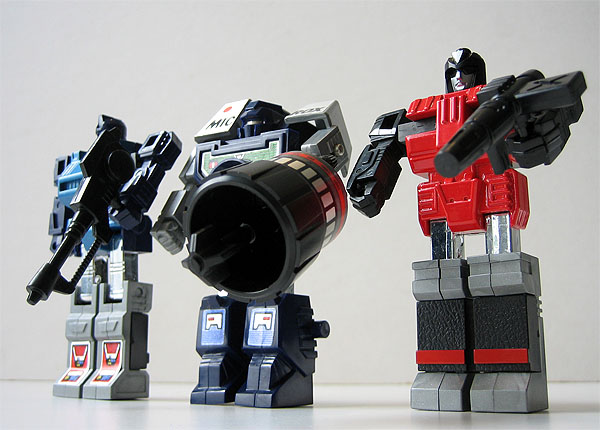
A great many thanks to those who once again contribute so much to these articles, on this occasion to Paul Hitchens for the 21 Reflector artwork, paperwork scans, screen captures, Mailaway Reflector and hardcopy Microx pics, Jeroen Blok for MC-05 images, Marco Salerno for 21 Reflector, MC-05 and mailaway Reflector images and Martin Lund for the Microx collector's card images. I would also like to credit Fred's Workshop and Himawari for the information on moulding variations.
All the best
Maz

















